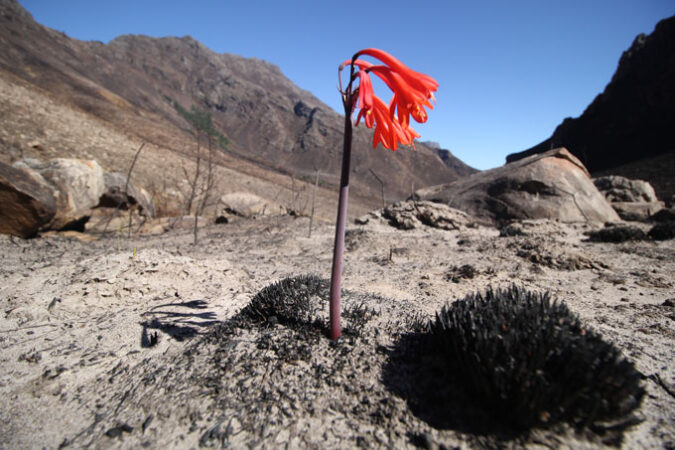Some plant roots draw a line in the sand — literally.
In South Africa, you can move between cool, green forest and sunbaked shrubland in a single stride. These narrow borders between dramatically different ecosystems are maintained by intense competition between plants’ roots, new research suggests.
Fynbos — a type of species-rich shrubland found only on the far southern tip of Africa — has the thinnest roots by far of any plant community in the world, researchers report in the March 1 Proceedings of the National Academy of Sciences. These nutrient-gobbling roots, plus some fire-encouraging adaptations, help turn the fynbos into an austere realm where only fynbos plants can survive.

Sign Up For the Latest from Science News
Headlines and summaries of the latest Science News articles, delivered to your inbox
Client key* E-mail Address* Go
Thank you for signing up!
There was a problem signing you up.
Interested in what factors organize nature at very broad scales, ecologist Lars Hedin and his colleagues wanted to look at places where environmental changes over time can flip the ecosystem between two distinct states.
Enter the fynbos. It’s a low, shrubby habitat home to mind-blowing plant diversity: more than 7,000 species, most of which are found nowhere else in the world (SN: 8/24/2004).
“It’s one of the most floristically biodiverse systems in the world,” says Hedin, of Princeton University. “It’s essentially as diverse as a tropical forest.”
But right next to this hot, flower-filled wonderland — with the same climate and underlying geologic composition — is the lush Afro-temperate forest, flourishing with tall trees and moss, but fewer species overall.
“The boundary is as sharp as one meter. It’s like a binary, zero to one transition,” says study coauthor Mingzhen Lu, an ecologist at the Santa Fe Institute in New Mexico. This is far narrower than the transition zone between savanna and tropical rainforest, he says, which can occur over many kilometers.
To investigate what underlies these sharp borders, the team compared root samples from both fynbos and forest systems. They also conducted transplant experiments, moving Afro-temperate forest plants to the fynbos and tracking their growth over four years. The researchers kept fynbos plant roots away from the transplants and manipulated nutrient levels in some plots to unveil limiting factors for the forest plants.
When kept away from fynbos roots or offered more nitrogen, forest trees grew five times as fast as those that experienced competition or nutritional disadvantage, the team found. That suggests the fynbos plants keep invading plants away by monopolizing nutrient access.
Below the surface, the story becomes even clearer. The fynbos plants have long, thin roots that act like nutrient-seeking missiles, snaking through the soil where other roots can’t reach.
“That’s a competitive advantage,” Hedin says. “That’s an underground weapon.”
The median root tip thickness in the fynbos plant community is about 0.1 millimeters, or around one-quarter to one-half the thickness of any other root system in the world. “The thickest fynbos roots are still thinner than the thinnest [Afro-temperate] forest roots,” Lu says.
Compared to the forest plants, fynbos roots are also 10 times as long. A gram of some fynbos plants’ root tissue – about the mass of a thumbtack – can stretch over 15 football field lengths of territory.
The researchers think that the fynbos creates “nutritional misery” for any nonfynbos plant, making the soil around the fynbos nutrient poor with their hyper-efficient roots. Also, a large proportion of fynbos shrubs and grasses are highly flammable, making the ecosystem prone to particularly intense fires. The fires burn so hot that they volatilize soil nitrogen into the air, removing those nutrients from the area too. Rather than engineering their surroundings to enhance nutrient levels, the plants may be doing the opposite — sabotaging the nutrient supply — to give themselves the upper hand against would-be encroachers.
 A fire lily (Cyrtanthus ventricosus) emerges after a fire in the highly nutrient-starved soils of South Africa’s fynbos ecosystem.Mingzhen Lu
A fire lily (Cyrtanthus ventricosus) emerges after a fire in the highly nutrient-starved soils of South Africa’s fynbos ecosystem.Mingzhen Lu
“You can try to invade, you’re not going to stand a chance,” Hedin says.
The fynbos-forest borders waver over the years between fire cycles, with the wet forest mostly rebuffing the flames and the fynbos eventually casting out trespassers.
A long prevailing idea about large ecological communities, Hedin says, is that they are largely driven by nonliving factors, such as climate, topography and geology, where organisms adapt to localized conditions. But in this case — and maybe others — “alternative stable states” arise from a war waging between organisms.
The findings demonstrate how pieces of this puzzle — fire, plant traits above and below ground and feedbacks between soil and plant, to start — illuminate the processes behind the creation and maintenance of the two coexisting vegetation zones, says Gerlinde de Deyn, a soil ecologist at Wageningen University & Research in the Netherlands not involved with the research.
The thinness of the fynbos plants is “striking,” de Deyn says, but the role of root-associated fungi in the ecosystem needs to be addressed. These fungi are normally heavily involved in soil nutrient cycling and could be contributing to the roots’ efficient nutrient uptake, rather than the roots doing it all by themselves.
In the fynbos, there may also be lessons for how root traits help or hinder the spread of invasive plants, Lu says.

